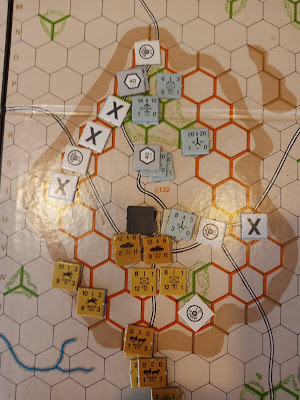The fighter group climbs to 4K and soon spots the enemy. Two
Nieuports are at 4K while the Fe2 is a thousand meters higher. The Allied
strategy is to engage the Germans and let their recon plane cruise by
unmolested. Reinhardt pulls back on his stick and begins his long climb to
intercept the Fe2. Once he gets in range the Fe2 doesn’t stand a chance. The
pusher-prop aircraft dives to increase speed, but the d3 is much faster. One
well-sighted blast and Reinhardt rips past the flaming Fe2. Pieces of scrap and
fuselage rain across the sky like tickertape. The Ace records his 6 kill, banks
hard left and dives towards his wingmen. They must have rattled the Allied
fighters. The Nieuports are diving for the home front and Norbert and Christian
seem keen on pursuing. Reinhardt follows after until they see his wing-wag and
the fighter group returns victorious to the aerodrome.
With Mission 1 a failure Mission 2 is sent immediately out.
The rain is hard driving and the recon group climbs high hoping to get above
the clouds. 4,500-5,000 meters and the rain is present. O’Dennell’s coordinates
are the same as the last chap’s. And he didn’t come back. “When you see the
Huns, dive to the deck and make your run.” This is what Workman had told
everyone yesterday. “The fighters will keep the enemy off your tail long enough
to take your photos. Remember, no photos means no successful mission. No
successful mission and poor Teddy down there doesn’t get to go home!” I wonder
if Workman forgot to follow his own advice? There was no debrief to be had so O’Dennell
could only speculate.
Five more minutes and many compass corrections later O’Dennell
starts to dive. He can’t see anything from the front perch of the Yorkshire
Pudding this high up in the rain. The brown, ugly cut of the trench lines
cones into view. No sign of his escort? Then the wet droning in the wind is
ripped apart by screaming air and hissing bullets! A German fighter comes out
of the black clouds on O’Dennell’s 10 o’clock, stitching his left wings and tail
section. A Nieuport gamely follows in hot pursuit but the Albatross seems
unphased by its fire. I wonder how much harder I can dive? O’Dennell wonders.
Then, he can’t, doesn’t want to believe his eyes. A shadow, a fury of grey
death rings yellow fire at him. He doesn’t even hear the growling diesel engine
as the Alb3 kills him in the onslaught of head-on gun fire. The Fe2 lopes
forward and spirals down with a dead man at the stick.
With two failed missions in a row the squads operational
staff is in a panic. Emmerson suggests flying a decoy. Scrub mission 3 and send
up instead a single bomber. At the plane’s ceiling, just like the last two.
When the Germans scramble to intercept we send in a flight of Nieuports low and
hit our urban bombing target of the day, Mission 4. The Germans should have
less planes to throw at our bombing mission since we have three busy elsewhere.
Westly draws the short straw and is sent up in the Paradise Garden without escort. He is instructed to fly at ceiling towards the same point as the last two missions. When he has lured out German fighters, hopefully three of them, he is to turn around and fly back as fast as he can. 60th squad air control gives the bomber from the 11th ten minutes lead out before the flags are shown for the 3 fighters going out to conduct the real bombing mission. Taylor, Lee and Hildred in route have a mind only for vengeance. The squad has yet to see a bomber safely home and Jasta 11 has been chasing them away with their fields of twin-Vickers machine gun fire. The bombing target can wait. But no one challenges the Allied flight. They line up over the city road junction and toss their bombs over the side. Not until they are returning over the Allied lines do they encounter the d3 Gottes Verrater and the d2 Schuchtermer Rabe. Trying to use their numbers against the Germans, all three pilots head for the d2. Dietmar is no coward and both Albatross’ charge at the attacking Nieuports. The Crimson Claw is smoked by Korbinian but Taylor gets a lucky critical firing defensively and the Gottes Verrater ends up with severed elevator cables. Korbinian banks left in a bid for friendly lines. Lee and Hildred joust with Dietmar. All three planes are taking hits and Hildred breaks apart under a blast from Dietmar’s Vickers. Only Lee is left and he is not giving up until one of the two pilots remaining is dead. An engine hit forces the Schuchtermer Rabe to lose power and go into a glide. Lee makes another pass and kills the German with a well-sighted tail attack. HQ will call this mission a success! Lee sees it as the German side of the ledger still is not in the red!
With no break in the weather and the wet fields of muddy France
being lashed by freezing rain XIII Army HQ orders another recon mission
immediately. They have not received any useful intel from the Wall Cat’s today and
are ordered to photograph road networks immediately behind the German trenches.
HQ needs these photos or the ground attack tomorrow in this sector will be going
in blind. Failure is not an option! Elton from the 11th and Brendan
and Tye of the 60th are tasked with the group’s most important
mission yet!






















